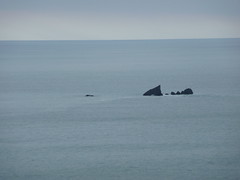Traduzione by CARLO CARADONNA, volontario di English Gratis. Il testo originale è tratto da una pagina del sito inglese di Wikinews ed è disponibile nel rispetto della licenza Creative Commons Attribution 2.5
![]() photo credit: ATIS547
photo credit: ATIS547

Loch Ness Monster
Il mostro di Loch Ness
The Loch Ness Monster is an alleged creature purportedly inhabiting Loch Ness in Scotland.
Il mostro di Loch Ness è un presunto essere vivente che, a quanto si dice, ha il proprio habitat a Loch Ness in Scozia.
Popular interest and belief in the animal has fluctuated since it was brought to the world’s attention in 1933.
L’interesse e la credenza popolare che ruota attorno all’animale oscillano sin da quando è stato posto all’attenzione del mondo nel 1933.
Evidence of its existence is largely anecdotal, with minimal and much disputed photographic material and sonar readings.
Le prove della sua esistenza sono in gran parte di natura anedottica, unitamente ad una documentazione, di minima consistenza e molto discussa, costituita da materiale fotografico e rilevazioni effettuate con il sonar (1) .
The scientific community regards the Loch Ness Monster as a modern-day myth, and explains sightings as a mix of hoaxes and wishful thinking.
La comunità scientifica considera il mostro di Loch Ness come un prodotto della mitologia (lett.mito) contemporanea, e spiega gli gli avvistamenti come un mix di burle e di forme di autosuggestione indotta dal desiderio che quanto immaginato si realizzi.
>>> Despite this, it remains one of the most famous examples of cryptozoology.
Tuttavia, esso rimane uno degli esempi più famosi di criptozoologia.
The legendary monster has been affectionately referred to by the diminutive Nessie (Scottish Gaelic: Niseag) since the 1950s.
Sin dagli anni ’50 ci si riferisce al mostro leggendario, in una forma familiare (lett.in una forma affettuosa), con il diminuitivo Nessie (Gaelico scozzese:Niseag).
Origins
Origini
The term “monster” was reportedly coined on 2 May 1933 by Alex Campbell, the water bailiff for Loch Ness and a part-time journalist, in a report in the Inverness Courier.
Da quel che si dice l’appellativo “mostro” fu coniato il 2 maggio 1933 da Alex Campbell, il guardapesca assegnato a Loch Ness e giornalista part-time, in un servizio per l’ “Inverness Courier”.
On 4 August 1933, the Courier published as a full news item the claim of a London man, George Spicer, that a few weeks earlier while motoring around the Loch, he and his wife had seen “the nearest approach to a dragon or pre-historic animal that I have ever seen in my life,” trundling across the road toward the Loch carrying “an animal” in its mouth.
Il 4 agosto 1933, il “Courier” dedicò la pubblicazione di un intero articolo alla dichiarazione rilasciata da un signore londinese, George Soicer, il quale alcune settimane prima durante un giro in auto nei dintorni del Lago, insieme alla moglie, aveva assistito al (come riferito testualmente) “più ravvicinato accostamento ad un drago o ad un animale preistorico che io abbia mai visto in tutta la mia vita”, che si muoveva pesantemente da una parte all’altra della strada diretta al Loch (lago) portando “un animale” nelle fauci.
The following month, another letter came from a veterinary student reporting a similar encounter while on a night drive.
Il mese successivo, arrivò un’altra lettera da parte di uno studente di veterinaria che riferiva di un simile incontro avuto durante un viaggio notturno in auto .
These stories soon reached the national (and later the international) press, which talked of a “monster fish,” ’sea serpent,” or “dragon”, eventually settling on “Loch Ness Monster.”
Queste storie raggiunsero in breve tempo la stampa nazionale (e successivamente quella internazionale), che parlò ora di un “pesce mostruoso”, ora di “un serpente marino”, ora di “un drago” (lett. o … oppure … oppure …), per poi attestarsi alla fine sull’attributo “mostro di Loch Ness”.
On 6 December 1933 the first purported photograph of the monster, taken by Hugh Gray, was published, and shortly after the creature received official notice when the Secretary of State for Scotland ordered the police to prevent any attacks on it.
Il 6 dicembre 1933 fu pubblicata quella che si suppone sia la prima fotografia del mostro, scattata da Hugh Gray, e subito dopo l’animale ottenne un attestato di considerazione ufficiale quando il segretario di stato per la Scozia diede disposizione alla polizia di evitare qualsiasi azione di attacco nei suoi confronti.
Other letters began appearing in the Courier, often anonymously, with claims of land or water sightings, either on the writer’s part or on the parts of family, acquaintances or stories they remembered being told.
Incominciarono ad apparire nel Courier, altre lettere, spesso anonime, che riportavano dichiarazioni circa avvistamenti per terra o nelle acque (del lago), effettuati dall’autore delle medesime lettere oppure dai suoi familiari o anche da conoscenti; queste segnalazioni potevano anche fare riferimento a storie loro raccontate di cui si era mantenuto il ricordo.
In 1934, interest was further sparked by what is known as The Surgeon’s Photograph.
Nel 1934, l’interesse fu ulteriormente ravvivato da quella che è conosciuta come la fotografia del chirurgo.
In the same year R. T. Gould published a book, the first of many which describe the author’s personal investigation and collected record of additional reports pre-dating the summer of 1933.
Nello stesso anno R.T. Gould pubblicò un libro, il primo di una lunga serie di opere che descrivono i risultati dell’attività di indagine condotta personalmente dall’autore e fece una raccolta della documentazione relativa a ulteriori notizie che risalgono a un periodo antecedente all’estate del 1933.
Other authors made claims that sightings of the monster went as far back as the 6th century.
Altri autori sostennero che gli avvistamenti del mostro risalgono almeno al sesto secolo .
(1) Designazione internazionale dei vari mezzi di ricerca subacquea fondati sull’emissione di ultrasuoni e sulla captazione dei relativi echi.


